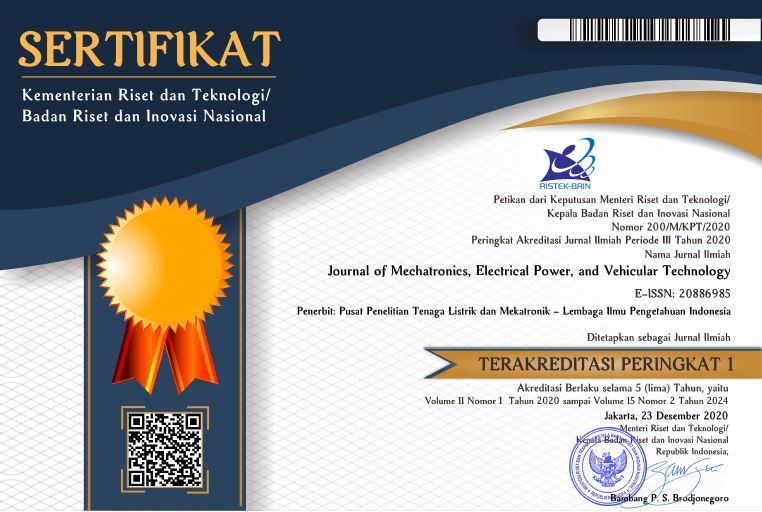Quasi-dynamic hosting capacity in radial distribution feeder
Abstract
The target of massive installation of renewable energy is the focus of this research. Several industrial sectors continue to install photovoltaic rooftop to support green energy. One of the main objectives of this research is to see the maximum impact of installing a photovoltaic rooftop at 1 point of customer and spread capacity for each customer. This research uses a radial distribution network system that closely resembles the distribution network in Indonesia, where the load profile considers the load characteristics of industrial, commercial, and residential loads. This study uses the line equation theorem method to calculate the voltage rises by considering two current measurement points: the current at the end and the current at the base. The obtained voltage rise is then accumulated to be summed up with the customer afterward. The results are obtained by considering three scenarios: 1) voltage limits, 2) voltage limits and line loading, and 3) voltage limits, thermal, and harmonics in accordance with regulations. The obtained results are closely aligned with the simulations performed on the hosting capacity software such as DIgSILENT.
Keywords
Full Text:
PDFReferences
PT. Perusahaan Listrik Negara, “Rencana Usaha Penyediaan Tenaga Listrik (RUPTL) PT PLN (Persero) 2021-2030.,” PT Perusahaan Listrik Negara, 2021.
President of Republic of Indonesia, Undang-Undang Nomor 7 Tahun 2021 Tentang Harmonisasi Peraturan Perpajakan, no. Pemerintah Pusat. Jdih BPK RI, 2021, pp. 1–6.
Kementrian Energi dan Sumber Daya Mineral, Peraturan Menteri Eenergi dan Sumber Daya Mineral Republik Indonesia No. 20 Tahun 2020 Tentang Aturan Jaringan Sistem Tenaga Listrik (Grid Code). Kementerian Energi dan Sumber Daya Mineral, 2020, p. 1019.
S. M. Ismael, S. H. E. Abdel Aleem, A. Y. Abdelaziz, and A. F. Zobaa, “State-of-the-art of hosting capacity in modern power systems with distributed generation,” Renew. Energy, vol. 130, pp. 1002–1020, Jan. 2019.
M. Zain ul Abideen, O. Ellabban, and L. Al-Fagih, “A Review of the Tools and Methods for Distribution Networks’ Hosting Capacity Calculation,” Energies, vol. 13, no. 11, p. 2758, Jun. 2020, doi: 10.3390/en13112758.
K. D. Shinde and P. B. Mane, “Investigation of Effects of Solar Photovoltaic Penetration in an IEEE 13-bus Radial Low-Voltage Distribution Feeder System,” in 2022 19th International Conference on Electrical Engineering/Electronics, Computer, Telecommunications and Information Technology (ECTI-CON), May 2022, pp. 1–5.
M. U. Qureshi, A. Kumar, S. Grijalva, J. Deboever, J. Peppanen, and M. Rylander, “Fast Hosting Capacity Analysis for Thermal Loading Constraint Using Sensitivity-based Decomposition Method,” in 2020 52nd North American Power Symposium (NAPS), Apr. 2021, pp. 1–5.
T. Gonen, Electric Power Distribution Engineering. Power and Energy: CRC Press, 2015.
J. Yuan, Y. Weng, and C.-W. Tan, “Determining maximum hosting capacity for PV systems in distribution grids,” Int. J. Electr. Power Energy Syst., vol. 135, no. January 2021, p. 107342, Feb. 2022.
M. U. Qureshi, S. Grijalva, and M. J. Reno, “A Rapid Quasi-Static Time Series Method for Evaluating Current-Related Distributed PV Impacts including Feeder Loading and Line Losses,” in 2019 IEEE Power & Energy Society General Meeting (PESGM), Aug. 2019, vol. 2019-Augus, pp. 1–5.
T. E. Castelo de Oliveira, M. Bollen, P. F. Ribeiro, P. M. S. de Carvalho, A. C. Zambroni, and B. D. Bonatto, “The Concept of Dynamic Hosting Capacity for Distributed Energy Resources: Analytics and Practical Considerations,” Energies, vol. 12, no. 13, p. 2576, Jul. 2019.
M. D. Braga, S. D. Machado, I. C. Oliveira, T. E. C. de Oliveira, P. F. Ribeiro, and B. I. L. Lopes, “Harmonic Hosting Capacity Approach in a Radial Distribution System due to PV Integration Using OpenDSS,” in 2018 13th IEEE International Conference on Industry Applications (INDUSCON), Nov. 2018, pp. 222–228.
M. Al-Saffar, S. Zhang, A. Nassif, and P. Musilek, “Assessment of Photovoltaic Hosting Capacity of Existing Distribution Circuits,” in 2019 IEEE Canadian Conference of Electrical and Computer Engineering (CCECE), May 2019, pp. 1–4.
D. Syafrianto, K. Marojahan Banjar-Nahor, and N. Hariyanto, “Optimized Allocation of Solar PV in Batam-Bintan Power System 2021-2025,” in 2021 3rd International Conference on High Voltage Engineering and Power Systems (ICHVEPS), Oct. 2021, pp. 149–154.
S. K. Sahu and D. Ghosh, “Photovoltaic Hosting Capacity Increment in an Unbalanced Active Distribution Network,” in 2021 1st International Conference on Power Electronics and Energy (ICPEE), Jan. 2021, pp. 1–5.
E. Kazemi-Robati, H. Hafezi, R. Faranda, M. S. Sepasian, and P. Sodini, “Hosting Capacity Enhancement and Voltage Profile Improvement Using Series Power Electronic Compensator in LV Distribution Networks,” in 2021 International Conference on Smart Energy Systems and Technologies (SEST), Sep. 2021, pp. 1–5.
N. Soukaina, I. Moufid, A. Boharb, H. E. L. Moussaoui, T. Lamhamdi, and H. El Markhi, “Analysis and comparison of PV hosting capacity mathematical models: A case study of a Moroccan distribution grid,” in 2022 2nd International Conference on Innovative Research in Applied Science, Engineering and Technology (IRASET), Mar. 2022, pp. 1–5.
D. S. Nair and R. T, “Investigation on Impact of Solar PV penetration on the Operation of Protective Relays in a Distribution System using Python,” in 2021 IEEE Conference on Technologies for Sustainability (SusTech), Apr. 2021, pp. 1–8.
S. Ismael, S. Abdel Aleem, A. Abdelaziz, and A. Zobaa, “Probabilistic Hosting Capacity Enhancement in Non-Sinusoidal Power Distribution Systems Using a Hybrid PSOGSA Optimization Algorithm,” Energies, vol. 12, no. 6, p. 1018, Mar. 2019.
B. A. Thango, U. B. Akuru, J. A. Jordaan, L. S. Sikhosana, and A. F. Nnnachi, “Evaluating the Harmonic Effects on the Thermal Performance of Distributed Photovoltaic Power Generation Systems,” in 2021 IEEE PES/IAS PowerAfrica, Aug. 2021, pp. 1–5.
DIgSILENT PowerFactory, “User Manual - DIgSILENT PowerFactory Version 15,” DIgSILENT GmbH, Heinrich-Hertz-Straße 9, 2014.
Article Metrics
Metrics powered by PLOS ALM
Refbacks
- There are currently no refbacks.
Copyright (c) 2023 Journal of Mechatronics, Electrical Power, and Vehicular Technology

This work is licensed under a Creative Commons Attribution-NonCommercial-ShareAlike 4.0 International License.














